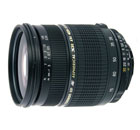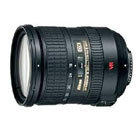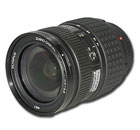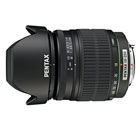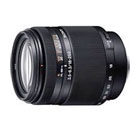
August 31, 2008
Having trouble viewing this newsletter? Read the latest issue online at
https://www.digital-slr-guide.com/dslr-news.html or read back issues
If someone you know has forwarded you this newsletter and you've enjoyed it, subscribe now to receive the next issue when it's published.
DSLR News - August 2008This month's Digital SLR Guide newsletter is all about an essential component of any digital SLR system: the lens.Without a lens to focus the outside world onto the camera's sensor, a digital SLR is essentially a blind paperweight (or at least a very nearsighted paperweight). When you pop a lens onto your camera, everything snaps into focus and you're able to start taking pictures. Putting the cheapest lens you can find on your digital SLR is equivalent to buying the cheapest pair of glasses you can find to correct your vision. While you might see some improvement over not having the glasses at all, chances are you could see things a whole lot better if you paid the extra cost for glasses with better optics. The same applies to a camera lens: its whole purpose in life is to focus a clear image straight onto the digital sensor inside your camera. Lenses with cheap optics don't focus the image nearly as well as lenses with more expensive components. If you've been disappointed with the sharpness and clarity of the photos coming from your digital SLR camera, chances are that it's the lens that's causing the problem, not your camera. You might even have experienced a moment of sheer panic when you realized that the photos captured by your cheap compact digital camera looked better than the ones from your ultra-expensive SLR. The reason is simple: compact digital lenses have been optimized for the camera bodies they're attached to. Since the lens is actually part of the camera, manufacturers can ensure that the lens is focusing a nice sharp image onto the digital sensor. With an SLR, it's not so simple. There are some notable exceptions to this rule, but just about any SLR lens that you can put your hands on for less than $100 will hinder your images more than it will help. After years of ongoing research, I've found that there's a sweet spot for lens prices: a place where you're paying enough to get a lens with great optics but not exceptional optics (since the difference between these two can be hard to tell). This sweet spot is anywhere between $300 to $600 - although a lot will depend on the TYPE of lens that you're considering. For example, standard zoom lenses are pretty common these days, and competition means that you can find a great lens for closer to the $300 price point. But if you're considering the purchase of a nice big telephoto zoom you're going to have to part with $600 or more. Regardless of what you decide, it's important to do research first. Start with my 6-step guide to buying a digital SLR lens, and use online resources like Fred Miranda's web site to read actual user reviews of how a lens performs. |
In This Issue
Latest SLR Guides
Canon Rebel XSi
Pentax K20D
Canon 40D
Olympus E-510
Nikon D80
Canon Rebel xTi
Nikon D40
Digital SLR Terms
Megapixels
Stabilization
ISO / Image Noise
Sensor Dust
Crop Factor
RAW vs. JPG
Continuous Photos
Autofocus Points
Aspect Ratio
Lens Terms
Focal Length
Prime vs. Zoom
Maximum Aperture
First vs. Third Party
SLR Lens Features
Canon Lens Glossary
Nikon Lens Glossary
|
Recently Updated
ALL NEW! I have gone back and re-written every page of my digital SLR dictionary to improve and update the quality of the information provided. For anyone considering a new digital SLR purchase and confused about terms like ISO, image stabilization and dust control, it's worth another look.- Define Digital SLR Terms
- Canon Digital SLR Cameras (added the new 50D)
- Nikon Digital SLR Cameras (added the new D90)
- Top Rated Digital SLR Camera
Coming Soon
- Nikon D60 Guide
- Olympus E-520 Guide
- Sony DSLR-A300 Guide
- Best Macro (Closeup) Lenses
- Best Low Light Lenses
Digital SLR Q & A
Question: What is focal length and why does it matter?
Answer
The focal length is a property of your camera's lens and different focal lengths allow you to capture either more or less of the scene or subject in front of you.Here's the summary information:
- Focal lengths are measured in millimeters
- Short focal length lenses (10-20mm) are also called wide angle
- Medium focal length lenses (28-100mm) are also called regular
- Long focal length lenses (200-400mm) are also called telephoto
- Lenses with only one focal length are called prime lenses
- Lenses with variable focal lengths are called zoom lenses
All well and good - but what type of focal length should you use when taking photos? The answer to this question depends entirely on your subject, and the subject-to-camera distance.
EXAMPLE #1
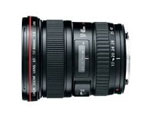
For this photo session you'll want to use a regular zoom lens: something with a variable focal length between 28 and 100mm. The 28mm (wide angle) setting will allow you to capture all three kids standing next to each other, while the 100mm (telephoto) length will capture some nice closeups, even if you're some distance away.
EXAMPLE #2
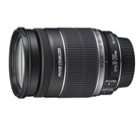
In this case, you need a telephoto zoom lens with focal lengths anywhere between 200 and 400mm. These long focal lengths will allow you to get up close and personal with your subjects, even though you're a fair distance away from all the action.
EXAMPLE #3
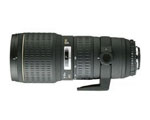
If you've watched any Olympic coverage, you may have seen a cluster of photographers, all with these absolutely enormous lenses on their cameras. Most of those lenses are extreme telephoto primes: lenses with focal lengths around 600mm.
These long focal length lenses allow the photographers to capture the events and expressions of the competitors, even from a considerable distance.
DSLR Cheat Sheet
This month's cheat sheet covers a topic that's simple to re-create but that takes a long time to master.The topic is this: how to capture portraits with very blurry backgrounds.
Once you've taken enough photos of people, you begin to realize something: the background behind the person is as important - if not more so - than the person you're photographing.
A great background can create a sense of space: it provides the viewer with context about the location of the portrait. Additional information you want to convey about the subject - social status, personality type, profession - can be conveyed by a well-selected background.
On the flip side, a background that's too busy competes with your primary subject, drawing attention away from the portrait and toward the clutter in the image.
This is why many portrait photographers deliberately blur the background so substantially that specific details become unrecognizable.
There are three steps you need to take in order to capture these types of portraits:
- Set your lens to its telephoto setting (a longer focal length)
- Open the lens aperture as wide as it will go (in aperture priority mode, select a small f number)
- Get up close and personal with your subject
All three of these variables have an impact on something called depth of field: this is the distance in front of and behind your primary subject that appear clear in your photo.

When you're working with a shallow depth of field (as is the case when you follow the three steps above) only the subject of your portrait will be crystal clear, and the background - whatever it may be - will blur out into a wash of color that doesn't draw attention away from your primary subject.
Get the Most From Your Digital SLR Camera
- Learn digital SLR camera jargon in 5 online lessons
- Master the controls of your digital SLR
- Dramatically improve the photos you take
- Learn at your own pace - review the lessons any time
- NEW! Download all 5 lessons to read on the go
What Do You Need?
This month I'll answer the question: do you need a lens with a constant maximum aperture?Before I dig into the answer to this question, it helps to have a better understanding of the alternative: variable maximum aperture.
The maximum aperture of your digital SLR lens represents the widest opening the lens can achieve, which allows the greatest volume of light to land on the sensor. Lens maximum apertures are always marked on the lens itself - if you hear someone chatting about a 28-135mm f/2.8, the 2.8 number is the maximum aperture of that particular lens.
If you have a kit lens for your digital SLR, you might have noticed that there are actually TWO numbers instead of one. This is because all kit lenses have variable maximum apertures.
Simply put, the maximum aperture of the lens is not the same at the wide angle setting as it is at the telephoto end. The maximum opening of the lens narrows the more you zoom.
In the case of an 18-55mm f/3.5-5.6 (the most common kit lens), the maximum aperture at 18mm is f/3.5 while at 55mm the max aperture narrows to f/5.6 (the larger an aperture number, the smaller the opening in the lens).
Now consider the following lens: a 28-75mm f/2.8. Since only one aperture number is listed, this means that the lens has a CONSTANT maximum aperture throughout the zoom range. Whether you're at 28mm, 75mm or somewhere in between, the maximum opening in the lens never changes.
Now that we've got a better understanding of what a constant maximum aperture means, let's talk in more depth about whether or not you really need it.
Constant maximum apertures are most useful if you take photos with the camera set to manual exposure mode.
If you only ever use your camera in full AUTO mode (something that I don't recommend) it decides what the aperture and shutter speed settings should be. If you use manual mode, you are in control of both settings.
Let's say that you're using the camera in manual mode with a lens that has a variable maximum aperture (an 18-55mm f/3.5-5.6). With the lens set to 18mm, you open the aperture as wide as it will go (f/3.5). Using the camera's light meter, you figure out that a good shutter speed setting is 1/60th of a second.
With aperture and shutter speed set, you're ready to take some photos of your subject. But let's say that in the middle of the photo session, you zoom your lens to 55mm, which narrows the aperture to f/5.6. If you don't immediately change the shutter speed setting, you're going to get a photo that's under exposed (too dark).
If your lens has a constant maximum aperture, there's no need to worry: just dial in the right aperture and shutter speed and zoom the lens as much as you want. So long as the available light remains constant, the settings that you've selected don't have to change.
Recently Announced Digital SLRs
Canon 50D
The Canon 50D includes a host of features that will appeal to more advanced photographers: 15.1 megapixels, 6.5 continuous photos per second, ISO range from 100 to 12800, face detection autofocus, a more detailed LCD and an "Auto Lighting Optimizer" mode to keep exposures bright.The Canon 50D will be available in October of 2008, with an estimated selling price (with lens) of $1,600.
Nikon D90
Nikon broke the mold with their new digital SLR in a variety of ways: 12.3 megapixel sensor, 4.5 continuous photos per second, ISO range from 100 to 3200, 11 autofocus points, a new stabilized lens and a digital SLR first. The Nikon D90 will be the first digital SLR ever that will let you capture both still frames and high definition (HD) movies.The Nikon D90 will be available in September of 2008, with an estimated selling price (with lens) of $1,300.
Alternatives to the Kit Lens
Visitors to the Digital SLR Guide often ask me: what lens would you recommend as an alternative to the kit lens?After all, the kit lens that comes bundled with a digital SLR camera isn't top of the line - if it were, it would drive the price of camera and lens higher and make the overall price of the camera less appealing to consumers.
So what if you're looking for something just a TAD bit nicer, but without spending an obscene amount of money on a pro-grade lens?
The answers lie in the following selection of lenses - my choices mind you - but lenses that have received overall good reviews and that present a step up in image quality from just the basic SLR package.
For Canon
One good alternative to the regular 18-55mm lens that comes packaged with many Canon digital SLRs is the Canon EF-S 17-85mm f/3.5-5.6 IS USM.Its primary advantages over the kit lens include a wider zoom range and image stabilization, which can be quite useful if you don't want to lug around a tripod all the time.
About the only drawback is that is has the same variable maximum aperture as the standard kit lens and a fairly expensive $488 USD price tag.
A second alternative for those looking for a wide maximum aperture is the Tamron 28-75mm f/2.8 XR Di LD which lacks the image stabilization but makes up for it with exceptional optics and a wide constant max aperture of f/2.8 for the relatively affordable price of $360 USD.
For Nikon
If you can afford it - and that's a big if - then a great alternative to the standard kit lens is the Nikon 18-200mm f/3.5-5.6G ED IF AF-S VR (about $645 USD).This lens not only covers a much greater zoom range (from wide angle to telephoto) it also includes Nikon's image stabilization technology, called Vibration Reduction (VR).
Since the lens has an internal focusing mechanism, it is compatible with the Nikon D40, D40x and D60.
For Olympus
Any Olympus DSLR owner can't go wrong with the Olympus 14-54mm f/2.8-3.5 Zuiko ED ($400 USD).Offering a wide variable maximum aperture (great for low light photography) and producing incredibly sharp images, this lens also features weatherproofing for those who enjoy taking photos in less-than-ideal conditions.
For Pentax/Samsung
Like the alternative Nikon lens, there's a Pentax lens out there with a massive zoom range: the Pentax DA 18-250mm f/3.5-6.3 ED AL IF.This is one of those lenses that you can attach to the camera body and leave on at all times, whether you want to take scenic landscapes or close-up portraits.
The only drawback is the relatively narrow maximum aperture (eespeciallyat 250mm) which does limit your ability to use this lens in low light conditions (unless you have it attached to a K20D with its built-in image stabilization).
For Sony
Guess what? Like Nikon and Pentax, a good kit lens alternative for any Sony DSLR is the Sony Alpha DT 18-250mm f/3.5-6.3.Covering the exact same zoom range as the Pentax lens mentioned above (14x zoom to be exact) this is a good lens to leave on your camera at all times, especially if you're not sure what types of photos you'll want to take.
Links
The following collection of links will help to keep you posted about what's new at the Guide and in the world of digital SLR cameras.Other Photography Sites
- Betterphoto.com - a wealth of photography learning opportunities
- Photojojo - a great site with tons of photography do-it-yourself (DIY) projects
- Flickr - THE social media site for photographers
- Strobist - everything you ever wanted to know about lighting with external flash
- Photo.net - lots of learning resources and plenty of examples of exceptional photography
In Conclusion
Be prepared - the big Photokina trade show is next month and there are plenty of new camera announcements are right around the corner.Canon just announced the 50D, Nikon's out with the D90 (see above) and you can definitely expect to hear more from Sony very soon. Looks like I'm going to be quite busy as the year wraps up here.
Until next month...happy picture taking!
--Chris Roberts, Your Digital SLR Guide
